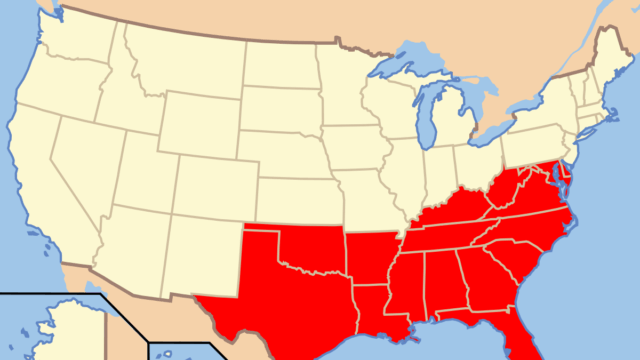Understanding the New South

President Trump delivered the commencement address at the University of Alabama last week. “You’re the first graduating class of the golden age of America,” he told the assembled seniors. His speech, besides talking about his record in office, mostly focused on sports and business. He knew the right topics to appeal to his crowd. Some may wonder why he didn’t bring up any of the usual tropes about the South. There were no mentions of Robert E. Lee or the threats to Confederate heritage. There were no paeans to Southern rusticity or its supposedly traditional way of life. Trump depicted the South as a sports-obsessed region with a dynamic, modern economy.
His speech captured the true spirit of the New South, showing he understood it more than its liberal detractors and reactionary admirers. The South no longer resembles its mythical version. It still retains some elements of the old South and it’s still pretty conservative, but one shouldn’t confuse it with the “Moonlight and Magnolia” image of the past.
Liberals, and many non-southerners, previously saw the region as a crappy backwater filled with racist hillbillies. You wouldn’t want to live around those toothless, inbred hicks. In their minds, there was little economic opportunity there. It was a stagnant region stuck in the 19th century.
Some liberals still see the South in this fashion, but it’s completely anachronistic. The South is no longer a backwater. It’s the center of the American economy. The region is now our industrial heartland while the once-thriving midwest is the Rust Belt. The South is the fastest growing region in the country, with people from all over moving there due to the booming business and attractive cities. Nashville, Charlotte, Huntsville, Atlanta, Dallas, and many other southern metros are hot destinations for college grads. If anything, the rest of the country looks like an economic backwater compared to the South.
This would shock Americans of previous generations. They would have never considered moving to the South. It had little industry, little growth, and little infrastructure. It was the poorest and least educated region in America, by far. What was there in the South besides poverty and humidity?
But that’s now the past.
The South’s transformation owes to a couple of different factors. A big one is technological advancement, such as air conditioning. Now people could experience the region’s brutal summers in relative comfort. Malaria and other tropical diseases were either contained or wiped out in the later 20th century, making the South more hospitable. The region also received an infusion of federal government support through the New Deal and the military-industrial complex, creating much-needed infrastructure for an economic boom.
The South’s business climate made it very attractive. Low taxes, minimal regulations, and right-to-work laws made it more attractive compared to the high taxes and powerful unions of the North. Southern lawmakers will also bend over backwards to attract investors. One notorious example is Georgia Gov. Brian Kemp begging Chinese companies to buy up farmland in the Peach State.
Along with business came pro sports teams. The Atlanta Braves became the first pro team in the proper South in 1966. Many more have followed. The South is now arguably the most sports-crazed region in the country. College football teams define who Southerners are and athletic ability is prized above all else.
Sports and business are what matter most to the New South, as Trump understood in his speech.
All of the wealth and entertainment options came with the South casting aside parts of its old identity. The war on Confederate heritage didn’t begin over the last decade. It started when the South began to emerge as an economic powerhouse that attracted people from all over America. The new arrivals may have taken to country music, Southern cuisine, and college football, but they didn’t relish the symbols of Dixie. Some newcomers are greatly offended by the Confederacy. But the majority didn’t care about it. It’s not their culture or heritage, so why should they cherish it?
It can be claimed that genuine southerners still cherish their Confederate heritage, and they do to a degree. But it’s not the same as it once was. Battles over Confederate flags would rile state politics in the not-so distant past. The number one issue in South Carolina at the turn of the century was the Confederate flag flying on top of the state capitol. Fifteen years later, the state was able to remove the flag from capitol grounds with hardly any pushback. In 2020, Mississippi’s legislature overwhelmingly voted to change its Confederate-themed state flag. It didn’t receive much of a backlash. Many monuments came down without a fight. You will see far fewer Confederate flags when you drive through the South today. Growing up, I’d see them all the time flying off front porches and as bumper decals. Seeing one today is so rare that it makes me salute it when I drive by. Even in the rural South, you are far more likely to see Trump and Gadsden flags than the Confederate battle flag.
Both the influx of non-southerners and southerners’ own changing attitudes explain these changes. As a Southerner under 40, I can attest to these changes. Among the middle-class I grew up with, Confederate flags were déclassé. You didn’t see them at my very conservative suburban high school. But even the youth from more rural areas felt a similar awkwardness around it. My college was filled with people from the country parts of Tennessee. Even they weren’t that big on the Confederate flag in the early 2010s. It would’ve been completely different a generation before. Students at Ole Miss fought fiercely against then-coach’s Tommy Tuberville’s efforts to ban the flag from Vaught-Hemingway Stadium in the 1990s. Fraternities throughout the South would fly the flag in this era. Popular rock and country bands from the region still liked to flaunt the flag in the time before Obama.
For younger southerners, it no longer represented heritage. At best, it symbolized being a redneck, which not everyone wanted to be. At worst, it represented hate. Wearing a rebel flag shirt into high school wouldn’t get you in trouble in the ‘80s, but it would in the 2000s.
Whether this sentiment was imposed or organic is a matter of debate. What is undeniable is the sentiment itself.
This is upsetting to many right-wingers who wish the South to resemble their own myth. In the imaginary South, honor culture reigns supreme, the people cherish their past, agrarianism is still a way of life, and the people eschew atomizing neoliberalism in favor of front porch communitarianism. It’s a fantasy drawn from Gone With the Wind rather than real-world experience.
But this isn’t the South at all. It’s future-oriented, industrial, entwined with the global economy, and not dwelling on its heritage or past traditions. Whatever gets in the way of making money and college football is discarded. That was evident in Mississippi’s decision to change the state flag. Its football programs complained to the legislature that it would hurt their ability to recruit black players. Lawmakers, faced with a battle between their heritage and college football, sided with college football. Most southerners would also make that choice.
Its lack of concern for the past isn’t entirely negative. The South is the complete opposite of modern Germany. Germany’s obsession with the past saddles it with immense guilt. The South, in contrast, lacks any guilt over its history. It feels no need to atone for slavery or Jim Crow. Fixating on these past “sins” is an unwelcome intrusion and gets in the way of business. The South is free from these historical burdens due to its people’s lack of interest in them. Apathy may not be ideal, but it’s better than mandatory ancestral guilt.
The South still has distinctive characteristics. It’s still got the accent, its distinctive food, country music, warm weather, football rivalries, evangelical Christianity, hospitality, and conservative politics. But the South is not the trad, reactionary fantasy it’s often imagined. It’s now more like the rest of America, for better or for worse. Most southerners are happy with that.
If you want to fit in the New South, don’t bother reading a biography of Robert E. Lee. Read a history of SEC football instead.
https://www.highly-respected.com/p/understanding-the-new-south
